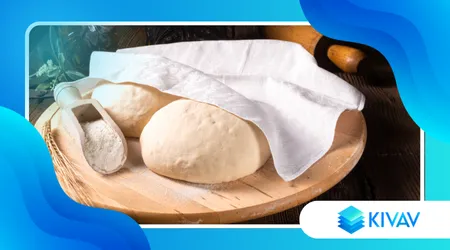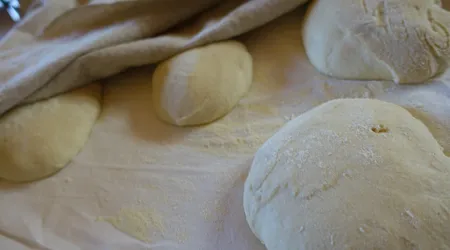Long-rising pizza dough

THE'long-rising pizza dough It's an art that combines tradition and science. Why choose slow leavening?
Announcements
Simple: the result is a light, fragrant, and easily digestible pizza. In Italy, where pizza is a cultural heritage, this method enhances flavors and textures.
In 2025, with growing attention to the quality of ingredients, the long-leavening technique dominates top-notch pizzerias.
This article explores the process, offering practical advice, original examples, and a step-by-step guide to achieving perfect dough.
Pizza isn't just food, it's an experience.long-rising pizza dough It requires patience, but rewards with a crunchy crust and a soft center.
Announcements
The current trend sees professional and amateur pizza makers experimenting with natural yeasts and extended resting times, often over 48 hours, for surprising results.
By following this guide, you'll discover how to transform flour, water, and yeast into a gastronomic masterpiece, using modern techniques and creative approaches.
Why choose long-rising dough?
The long leavening process improves digestibility. Enzymes break down starches, making the pizza lighter. This process also enhances the flavor.
A long-rising pizza dough It develops complex aromas. Slow fermentation allows the yeasts to release unique aromatic notes, similar to artisanal bread.
According to a 2023 study by the University of Naples, long-leavened pizzas have a lower glycemic index, promoting a balanced diet.
++ Homemade bread with a crispy crust
The texture is another plus. The pizza is crispy on the outside, soft on the inside, with air bubbles that delight the palate.
Finally, the technique allows for flexibility. You can prepare the dough ahead of time and let it rest in the refrigerator for optimal time management.

The perfect ingredients for the dough
Flour is the heart of thelong-rising pizza doughChoose a type 0 or 00 flour with a strength of W250-320 for the perfect balance.
The water must be pure and at room temperature. Too cold slows the yeast; too hot damages it. Quality matters.
Yeast, whether fresh or dry, must be used carefully. For 1 kg of flour, 1-2 g of fresh yeast is sufficient.
See also: Focaccia with Caramelized Onions
Salt enhances the flavor, but it should be added after the flour. Use fine sea salt, about 20 g per kilo.
Extra virgin olive oil, optional, adds softness. One tablespoon per kilo of flour is sufficient for excellent results.
Table: Basic proportions for the dough (1 kg of flour)
| Ingredient | Amount | Notes |
|---|---|---|
| Type 0/00 flour | 1 kg | Forza W250-320 |
| Waterfall | 600-650 ml | At room temperature |
| Fresh yeast | 1-2 g | Or 0.5 g of dry yeast |
| Salt | 20 g | Add after the flour |
| EVO oil | 20 ml (optional) | For greater softness |
The step-by-step preparation process
Start by dissolving the yeast in the water. Stir gently and let it sit for 5 minutes. This activates the microorganisms needed for leavening.
Pour the flour into a large bowl. Gradually add the water and yeast, mixing with your hands or a wooden spoon.
Once the dough comes together, add the salt. Continue kneading for 10 minutes until the dough is smooth and elastic.
If you use oil, add it at the end. Work thelong-rising pizza dough for a minute, ensuring uniformity without overheating it.
Shape the dough into a ball, cover with a damp cloth, and let it rest at room temperature for 8-12 hours, or in the refrigerator for 24-48 hours.
Times and temperatures: the secret of leavening
The long leavening process requires careful monitoring. At 25°C, the dough rests for 12-18 hours. In the refrigerator, it can last up to 72 hours.
The cold slows down the yeasts, improving the flavor. long-rising pizza dough in the fridge it develops richer crust notes.
Take the dough out of the oven two hours before baking. This brings it back to room temperature, making it easier to roll out without stress.
Don't rush the process with too much yeast. Patience is the key to a digestible and tasty pizza.
Monitor the environment. Humidity and drafts can affect the results. Use a covered bowl or proofing box.
Rolling out and cooking techniques
Divide the dough into 250-280g portions. This weight is ideal for 30cm diameter pizzas.
Roll out thelong-rising pizza dough with your hands. Avoid using a rolling pin to preserve the air bubbles created by the leavening process.
Preheat the oven to 250-280°C (480-520°F) and line it with a pizza stone. This ensures a crispy base, similar to a professional pizzeria.
Bake for 10-12 minutes, checking the edges. A well-aired crust is a sign of a well-baked dough.
For an even more authentic pizza, try a wood-fired oven. It reaches 400°C (750°F) and cooks in 90 seconds.
Practical examples to inspire you
Imagine a margherita pizza with a long-rising pizza doughUse San Marzano tomatoes, buffalo mozzarella, and fresh basil. The result? Intense flavor.
Or try a porcini mushroom pizza. The long-rising dough enhances the mushrooms' rusticity, creating a perfect balance.
Think of dough like a vintage wine. The longer it rests, the more refined the flavors become, turning every bite into an experience.
In 2024, a Neapolitan pizza chef won over customers with a 72-hour dough, serving pizzas as light as clouds.
Versatility is a strong point. Use thelong-rising pizza dough for gourmet focaccias or pizzas with local ingredients.
Mistakes to avoid
Don't use too much flour when kneading. It makes the dough dry, compromising the lightness typical of long leavening.
Avoid kneading too much. A long-rising pizza dough when overheated it loses elasticity, becoming difficult to work.
Don't neglect the resting times. Shortening the rising time reduces flavor and digestibility, ruining the process.
Check the oven temperature. Cooking at a low temperature makes the pizza rubbery, rather than crispy.
Finally, don't improvise the quantities. Accurate ingredients are essential for a professional and consistent result.
Long-rising dough in 2025

The trend for 2025 sees thelong-rising pizza dough At the heart of innovation. Pizza makers use sourdough for more intense flavors.
Pizzerias in Rome and Milan use stone-ground organic flours, perfect for 48-72 hour leavening.
A 2024 Gambero Rosso survey reveals that 78% of consumers prefer long-leavened pizzas for their lightness.
Technology helps. Apps like "Lievito" monitor resting times, simplifying the process for home pizza makers.
Experiment with ancient grains. Spelt or enkir flours, combined with long leavening, offer unique and sustainable flavors.
Conclusion
THE'long-rising pizza dough It's not just a technique, but a philosophy. It requires dedication, but the result is a pizza that tells a story.
Every air bubble, every crunchy bite is the fruit of a process that combines tradition and innovation. In 2025, this practice is more alive than ever, celebrated by those who seek quality and authenticity.
Whether you're an expert pizza chef or a passionate enthusiast, try this technique. It's more than just pizza; it's a journey of flavor. What flavor will you discover with your next pizza dough?
Frequently Asked Questions
How long should a long-rising dough rise?
12 to 72 hours, depending on the temperature (25°C or refrigerator). The longer it is stored, the tastier and more digestible it becomes.
Can I use sourdough starter for long-rising pizza dough?
Yes, sourdough starter adds aromatic complexity. Use 20% of the flour weight and prolong the rising time.
Which flour is better?
Type 0 or 00 flours with a strength of W250-320 are ideal. For unique flavors, try ancient grains like spelt.
How do I store the dough?
Refrigerate, covered, for 24-72 hours. Bring to room temperature 2 hours before rolling out.
